5.1 Basic system requirements
|
Previous
Chapter 4: Software
|
Next
Chapter 6: Social implications of hardware
|
 CHAPTER OVERVIEW
CHAPTER OVERVIEW
 By the end of this chapter, you will be able to:
By the end of this chapter, you will be able to:
- List and describe basic system requirements and how they relate to software
- Discuss the difference between installing software from an online download and a portable storage medium
- Describe the installation process
- Explain how to manage files and folders on a computer
INTRODUCTION
In this chapter, you will learn what basic system requirements are and how they link to software. You will learn how to install software from a portable storage medium (such as a CD) and from an internet download, as well as dig deeper into file management and what file attributes are. You will also learn how to import and export files and how to search for files.
UNIT
5.1 Basic system requirements
System requirements are the minimum necessary specifications that you will need to make sure that the software runs smoothly and does not overwork the hardware on your computer. It is basically a list of what you need to make sure that a game or program runs properly.
If your computer does not meet these requirements, you may not be able to install the software or, if you can install the software, it may run slowly. The system requirements for software are usually printed on the package that the software comes in or are listed on the software’s website.
Figure 5.1 below shows the list of system requirements for installing Photoshop.
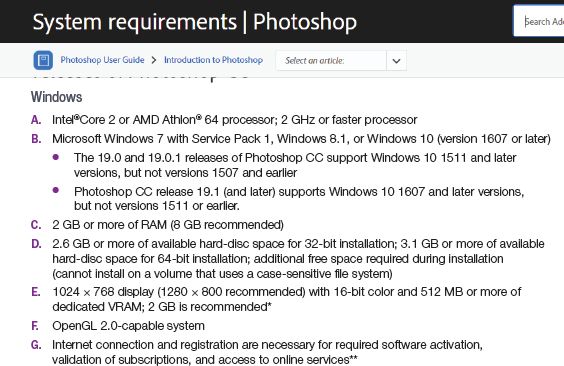
As you can see, the software makes several recommendations, including:
A.The type of CPU you will need (Intel® Core 2 or AMD Athlon® 64 processor operating at 2 GHz or faster).
B.The operating system you should be using (Microsoft Windows 7, 8.1 or 10).
C.How much RAM your system should have (a minimum of 2 GB but 8 GB is recommended).
D.How much space should be on your hard drive.
E.The size of your display (or screen).
F.Whether or not you will need an internet connection.
Knowing what the system requirements are for the software you will be using most often will help you decide what computer to buy when you are shopping for one. Most of the information you will need will be on a label on the computer or will be listed in an advertisement for the computer.
System requirements will also let you know if you need to purchase any additional hardware (such as microphones when using audio recording software). Hardware items, such as printers, also come with system requirements. For example, a printer may only be compatible with Windows 8.1 and 10 or Apple’s macOS and cannot be connected to a computer running Windows 7.
For your computer to be able to run all the newest gaming software, you would need to look at the graphics card. A GPU is a programmable logic chip to render images, animations and video for the computer’s screen. GPUs can be located in plug-in cards, in a chipset on the motherboard or in the same chip as the CPU. The gaming software’s system requirements will recommend the size of the additional GPU.
If your computer does not meet all the requirements to run specific software or communicate with a specific device, you will not necessarily have to buy a whole new computer. It is possible to upgrade your RAM, GPU or CPU. You can, for example, upgrade your operating system or you can install the latest device drivers to make sure that your computer and hardware can communicate with each other.
 Activity 5.1
Activity 5.1
1.Answer the following questions pertaining to the advertisements below:
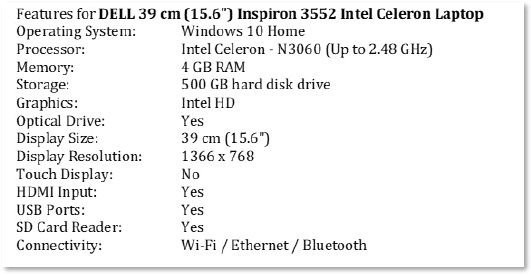
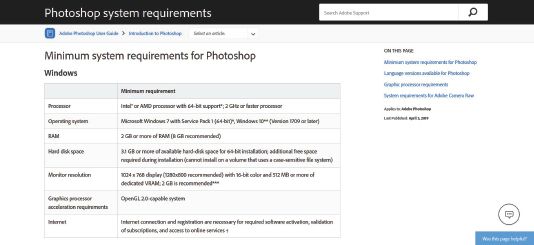
a.Does the DELL laptop have the minimum requirements for Windows 10? How can you be sure without looking at the minimum hardware needed for Windows 10?
b.What does OS mean in the Call of Duty: Modern Warfare 2 game requirements?
c.What does display resolution 1366 × 768 mean?
d.Describe what is meant by Touch Display.
e.Explain what 32-bit means.
f.Decide if the Call of Duty: Modern Warfare 2 and Photoshop in Figure 5.1 can be installed on the laptop and add relevant comments.
g.What does VRAM stand for?
h.State which component of the computer will be the easiest and cheapest to upgrade.
i.List the different processors’ names in the adverts and sort them from fastest to slowest.
2.Write True or False next to the question number. Correct the statement if it is FALSE. (You may not simply use the word NOT to change the statement.)
a.If your hardware does not meet the system requirements, it means that the software will not work.
b.Certain programs can run even if you have no RAM.
c.Certain programs cannot work if you do not have the right operating system.
d.The motherboard is the core component in a computer that brings all the different aspects of the computer together.
UNIT
5.2 Software installation
Once you have worked out what requirements you need to install software, you will need to begin the installation process. Before installing the software, you need to:
1.Download the software files from a website; or
2.Purchase a CD or DVD from a store.
After downloading the installation software, you can install it. Usually this installation software is an installation wizard to assist you with the installation process.
ONLINE DOWNLOAD
The most common way to get new software is to download it from the internet. To do this, you must go to the website where the software is available and download the files. Make sure that you download software from trusted publishers or verified retailers only. This ensures that you are getting the software you want and that you do not accidentally download malware or a virus.
You will usually use a credit card to buy the software to download. Once you have purchased the software, you will click on the download link to begin the process.
You can also buy software from app stores, such as Google’s Play Store, Apple’s App Store or the Windows Store. The software you are looking for is usually sorted according to its category, for example, gaming, word processing or design.
DOWNLOADING CHROME
To download software from the internet, do the following:
1.Go to https://www.google.com/chrome/ (or the site where the software is available to download).

2.Click on the Download button. A dialog box will appear. Accept the Terms of Service and make sure that you are downloading the correct version for your computer.
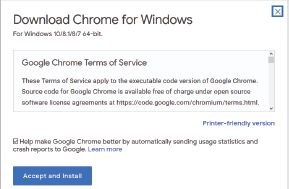
3.Follow the instructions to install the software.
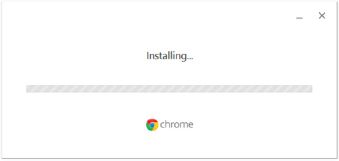
4.Open the application from the Start menu.
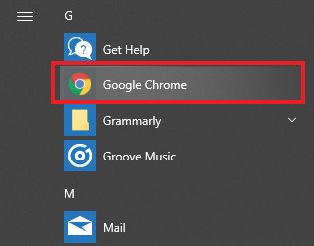
PORTABLE STORAGE MEDIUM INSTALLATION
Some software can be installed using the files found on a CD or DVD. This includes software such as the operating system, Microsoft Office (not Microsoft Office 365) and some games.
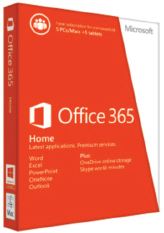
To get this software, you will need to go to a store and buy the product and bring it home with you to install. You do this by inserting the disk into your computer’s optical disk drive (its CD or DVD player). The installation program will usually start automatically but you can also look for the setup program to start the installation.
HOW TO INSTALL SOFTWARE
Once you have downloaded the software or inserted the disk, the installation wizard will guide you through what to do. While the installation wizard does not handle all the aspects of the installation, since these may be different from one program to the next, the process is very similar for all software.
SOFTWARE STEPS FOR INSTALLATION
You will usually start by either clicking on the downloaded file or inserting the disk and then letting the program setup file run (usually called Setup.exe or Install.exe).
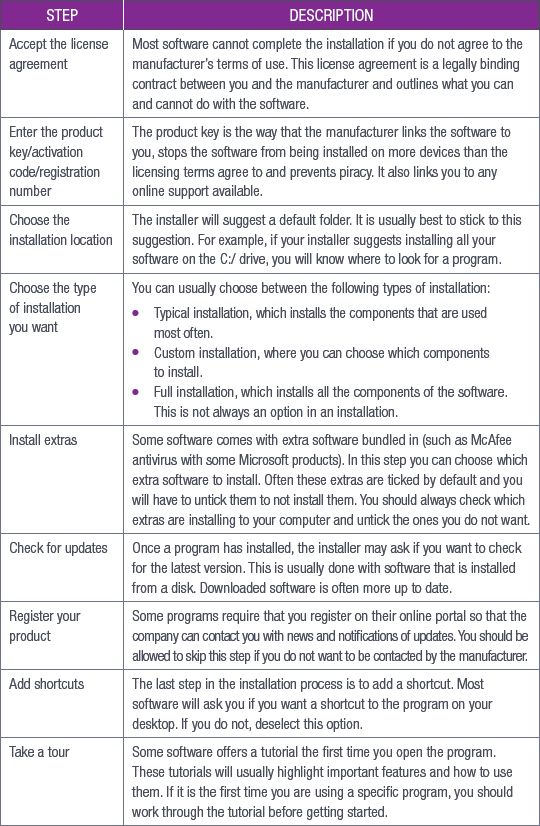
HOW TO UNINSTALL SOFTWARE
Uninstalling software is when you remove the program and all its files from your computer.
UNINSTALL A PROGRAM
To uninstall a program in Windows 10:
Step 1:Click on the Windows icon.

Step 2:Click on Settings.

Step 3:Click on Apps.

Step 4:Click on Apps & Features in the left pane. A list of all installed apps will appear.

Step 5:Click on the one you want to uninstall and then click on the Uninstall button (if this button is greyed out, it is a system app and cannot be uninstalled).

Step 6:Click on Uninstall in the pop-up window that appears and wait for the system to uninstall the app.
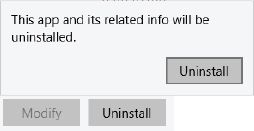
 Activity 5.2
Activity 5.2
1.Write True or False next to the question number. Correct the statement if it is FALSE. (You may not simply use the word NOT to change the statement.)
a.You completely eradicate the associated files and folders when you uninstall a program.
b.Some installation software files are sold on a flash disk.
c.The installation wizard will guide you through what to do when installing software.
d.Most hardware is already installed on the Microsoft operating system, thus most hardware are plug-and-play devices.
e.Most primary hard drives are saved with the drive location of E:\.
UNIT
5.3 File management
When you are setting up a file management system, there are several key things you need to look out for. You will need to know what types of files you are creating and how big those files are (so that you know how much of your computer’s resources they are using).
It also helps you to understand certain attributes that files have, such as hidden and read-only, and how to import/export files and how to search folders and drives for a specific file. This section will look at these aspects of files.
FILE TYPES
In Grade 10, you learned about file extensions and how they give you an idea of what content is likely to be in the file. File extensions usually link to a specific file type. For example, seeing a file that ends in .docx will let you know that it is a Microsoft Word document. File types indicate the specific characteristics of a document and will let the operating system know which program to use to open that file.
If you were to try and open an Adobe Photoshop document using Microsoft Excel, it would not work. Some file types are associated with specific programs, while others are standard file types that can be opened by a range of programs that support that file type. File types are not file formats, however. The file format usually describes the structure of the file and what it contains. Table 5.1 shows a list of file types and if they are program specific or standard.
Table 5.1: File types
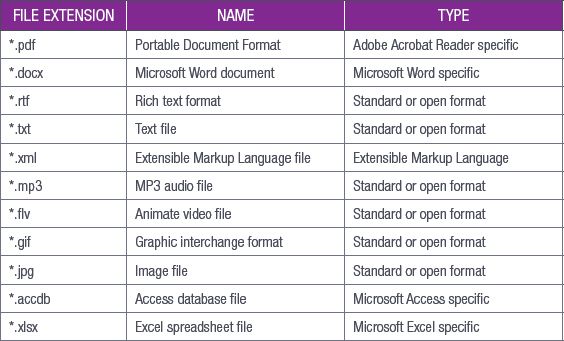

Something to know
You can find a complete list of all file types at FileInfo.com (https://fileinfo.com/).
When you are organising files, you can either organise them by file type or by subject.
PROPERTIES
The file Properties window shows you a range of information about a file, such as its file type, size and when it was last modified. It can also show you information on where a photograph was taken (its geo-location) and even what type of camera was used to take it. The Properties window will also give you information on how you can manipulate the file.
FILE PROPERTIES
1.To see the properties of a file, right click on the file name and select Properties.
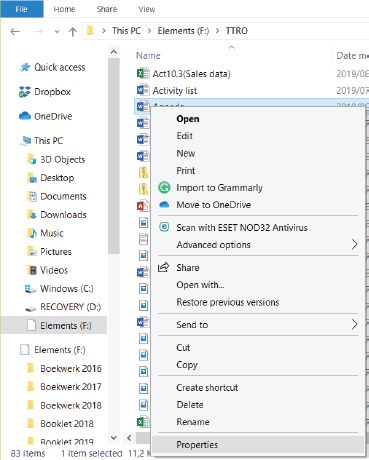
2.Click on Properties.
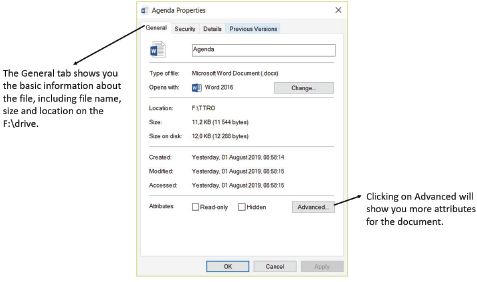
The Properties dialog box will give you information about the file, as you can see in the example above.
The General tab shows you the basic information about the file, including its name, size and location on the C:\ drive. It also shows attributes such as “read-only” and “hidden”. Clicking on Advanced will show you more attributes for the document. We will discuss these in more detail later on in this unit.
The Security tab allows you to change what access the system and other users have to the file. The Details tab gives you more in-depth details about the file, including its word count and what template was used to create it. The Previous Versions tab allows you to see if there are other versions of the file.
FILE ATTRIBUTES
File attributes are settings linked to computer files that give or deny certain rights to how a user or the operating system can access that file. There are several types of file attributes, but the most important are “read-only” and “hidden”.
Read-only files cannot be changed, edited or saved. They can only be opened and read. This is done to protect the data in the file from being edited accidentally. Hidden files are any files with the “hidden” attribute turned on. This means that these files are invisible while browsing through folders – you cannot see them without specifically allowing all of them to be seen.
IMPORT AND EXPORT
Most computer programs have their own way to organise and encode data into the files they save. Therefore, they can recognise their own files, but not necessarily those from another program. To be able to send or receive such files, it has to export or import the files. To export a file means to convert it into a format other than the one it is currently in. To import a file is to bring it from another program into the one you are using. This function allows different computer programs to read each other’s files.
Applications such as Access or Excel allow you to import or export your data from one file type to another. A good example of this is importing your Outlook data (.ost files) into Excel (.xlsx) or Word (.docx) files. This allows you to make a backup of your data.
You can also use this function to convert files from one file type to another. Importing files also allows you to quickly and easily move your files from one computer to another, especially if you are moving from an Apple product to a computer that uses the Microsoft Windows operating system.
SEARCH
You can use File Explorer to search for a file you saved. This is especially helpful if you have many files or you have forgotten where a particular file is stored. If you remember the file name, you can simply enter that in the search box in File Explorer.
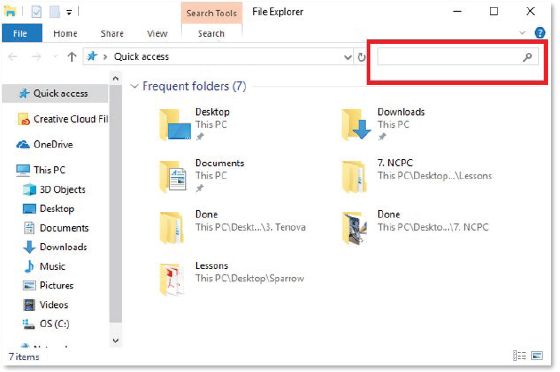
You can also search by file type or size. Using an asterisk wildcard (*) will let you search for groups of files, for example:
- *.txt searches for all text files.
- Home* will search for all files that start with “home”, such as homework.docx or homedesign.psd.
 Activity 5.3
Activity 5.3
1.Multiple choice:
a.Which attribute allows the user to view but not edit the file?
A.Hidden
B.Security
C.Read-only
D.Sharing
b.Which one of the following file extensions is not used in typing a report?
A..txt
B..docx
C..pdf
D..png
c.Which of the following file extensions is not part of the Microsoft Office 365 package?
A..txt
B..docx
C..xlsx
D..pttx
2.Match Column B with Column A:
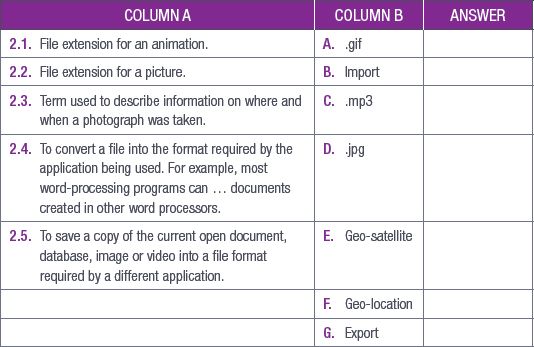
3.Write True or False next to the question number. Correct the statement if it is FALSE. (You may not simply use the word NOT to change the statement.)
a.You can find a complete list of all file types at FileInfo.com.
b.The file extension can indicate what type of data is on the file as well as what program is needed to open the file.
c.The most important file attributes are security and sharing.
4.Answer the following in your own words.
a.How do file extensions help you identify the type of document?
b.Give two examples of standard file types.
c.What does the Properties window tell you about a file?
d.Explain how you can see the file properties of a document.
e.What are read-only and hidden files?
f.Explain how you search for a file in Windows 10.
REVISION ACTIVITY
QUESTION 1: MULTIPLE CHOICE
1.1Which of the following is not a system requirement? (1)
A.Type of CPU
B.Type of RAM
C.Type of operating system
D.Storage capacity
1.2A hidden file is ___________. (1)
A.A file that cannot be changed
B.A file that cannot be edited
C.A file that will not display
D.A file that cannot be saved
1.3A software installer will use ___________. (1)
A.A password
B.An online verification system
C.A CD
D.An installer wizard
1.4Which of the following is an example of a program setup file? (1)
A.Word.docx
B.Photoshop.psd
C.Chrome.exe
D.Notepad.rtf
1.5A license agreement indicates the manufacturer’s __________. (1)
A.Terms of use
B.Contact details
C.Rules and regulations
D.Terms of agreement
QUESTION 2: TRUE OR FALSE
2Write True or False next to the question number. Correct the statement if it is FALSE. Change the underlined word(s) to make the statement TRUE. (You may not simply use the word NOT to change the statement.)
a.Before a person can use installed software, he or she must accept the license agreement. (1)
b.Uninstalling software involves removing the program and all its files from your computer. (1)
c.File properties are settings linked to computer files that give or deny users access to certain rights. (1)
d.Importing a file converts it from one format to another. (1)
e.Windows Explorer is used to search for files on a computer. (1)
QUESTION 3: MATCHING ITEMS
Choose a term/concept from Column B that matches a description in Column A. Write only the letter next to the question number (e.g. 1J). (5)
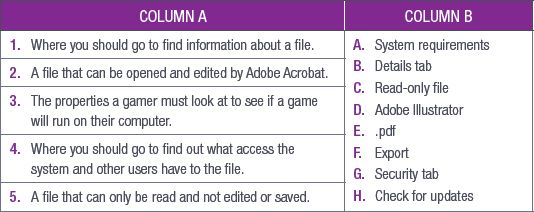
QUESTION 4: MEDIUM QUESTIONS
4.1Name two methods that can be used to install software. (2)
4.2What is the advantage of using a custom install method? (1)
4.3What is the difference between exporting a file and importing a file? (2)
4.4 two examples of file extensions for the following file types:
a.Audio files (2)
b.Text files (2)
c.Video files (2)
d.Picture files (2)
e.Document files (2)
QUESTION 5: SCENARIO-BASED QUESTIONS
The Civvie Computer Club meets once a week to discuss new and trendy computer-related topics. The club members frequently need to install new versions of software by using a CD. Installing software from a CD is easy since you just need to follow the installation wizard.
a.Briefly explain what an installation wizard is. (2)
b.Activation codes are usually sent via email. Explain what an activation code is. (2)
c.Explain the difference between a full and custom installation. (2)
d.The club members sometimes need to remove programs. Outline the correct way of uninstalling software. (2)
TOTAL: [40]
AT THE END OF THE CHAPTER

|
Previous
Chapter 4: Software
|
Table of Contents |
Next
Chapter 6: Social implications of hardware
|

